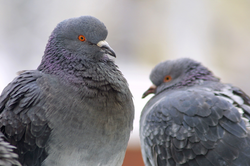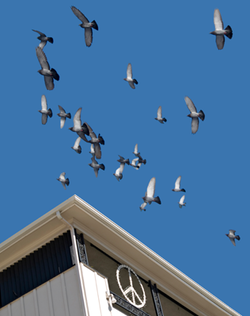
The pigeons are coming. So are blackbirds, starlings, house sparrows and crows. They’ll be invading your property en masse as bird season approaches. Will you be ready to get rid of birds when they arrive?
Prepare now or risk having your home invaded by birds. Your cars will be spotted with bird droppings. So will your windowsills and patio furniture. Larger pest birds will tear apart your roofing shingles, causing leaks. Smaller birds will build nests in your rain gutters, causing water to back up under your roofing tiles and, once again, you’ll have a leaking roof. Birds large and small will contaminate your pool and spa, so you’ll have to drain and clean them—not a pleasant thought.
Unless you have bird control devices in place, it will become increasingly difficult to get rid of pest birds. The temptation will be to use lethal means—like poisons or pellet guns—or stop-gap measures like water hoses and firecrackers. Eventually, under pressure from your kids and neighbors, you’ll agree to more humane bird deterrents. Devices that actually work. Here’s what the pros recommend:
Scarecrows for Pools, Spas and Gardens
Highly recommended for deterring all types of birds from areas where the presence of water is tolerated, Scarecrows are motion-activated sprinklers that spray a harmless but persuasive blast of water at any bird that wonders into its zone of protection. Scarecrows hook up to any standard garden hose and will guard a 1,200-square-foot area (or a 35-foot by 45-foot wide shape). The Scarecrow’s sensitivity and coverage area can be easily adjusted to suit the needs of your garden, pool or spa.
Bird Spikes for Roofs & Patio Covers
Birds usually seek a high perch from which to observe before they dive bomb your pool, spa, patio tables or car. Bird Spikes deny them that perch. Ideal for larger birds like pigeons and crows, Bird Spikes are harmless to birds, people and pets. They have earned the approval of the U.S. Humane Society and PICAS (Pigeon Control Advisory Service). The spiked strips come in rigid unbreakable polycarbonate (plastic) or durable stainless steel. Gutter spikes are also available to keep birds out of your rain gutters. All are easy to install using glue, screws, clips or tied downs.
Balloons and Diverters for Trees Known as Visual Bird Deterrents, Reflective Bird Diverters and Predator Eye Balloons bob and wave in the breeze to get rid of birds through intimidation. Diverters are tear-drop shaped panels covered with a big predator eye. They are hung in various lengths and spaced 2 to 3 feet apart. Predator Eye Balloons are covered with huge predator eyes. Look for visual deterrents made of weather-resistant vinyl plastic. For best results, it’s best to move these bird deterrents around often, or most birds will eventually get used to them as a non-live object to be ignored.

by Alex A. Kecskes
Almost everyone has heard about pigeons invading parks and monuments, shedding their disease-carrying droppings on statues and contaminating ponds and playgrounds. But pigeons also pose a problem to many businesses. And perhaps the least mentioned are the many problems pest pigeons pose to gas stations.
Take your basic gas station canopy, for example. Once pigeons have claimed them and decided to nest on them, it's just a matter of time before a flock of pigeons can ruin your average $25,000.00 canopy.
Why do so many pigeons like to nest on gas canopies? Simple. They provide a great observation point for pigeons. The resourceful birds like to sit along the canopy edges and survey the area. And if you've ever seen how these canopies are built, you know that they easily provide plenty of protected nesting sites on their undersides and gutter areas.
Unless you get rid of pigeons, the flat metal roof areas will soon be covered with pigeon droppings and nests. Both will clog the canopy's drains and eat away at the canopy's paint and metal. After a rain, one can't help but notice the brown residue and offensive odor caused by collected pigeon droppings and nesting debris. This debris and unsavory odor will collect on the covered paved areas of a gas station and create and unwelcome site for customers. Worse yet, left to gather in the wet, pigeon droppings can cause dangerous slip-and-fall hazards to customers and employees. After several years, gas canopies can even become structurally degraded to cause a possible hazard for motorists and workers.
So what to do? If high gas prices aren't enough to keep motorists away, do you really need pest pigeons? Fortunately, there are several humane and highly effective ways to get rid of pigeons.
Intimidating Bird Spikes
The mother of pest bird deterrents, the Bird Spike has saved more buildings and structures from pigeons than perhaps any other deterrent. Bird Spikes get rid of pigeons because they simply can't negotiate a landing around them. The spiked strips come in rigid U.V.-resistant unbreakable polycarbonate, or longer-lasting, slightly more expensive stainless steel, which you can get in a non-reflective metal finish. These days you can even get bird spikes in a full spectrum of colors--including white, tan, gray, black, brown, brick red and crystal clear. The spikes are easily glued or screwed to any surface. Choose the Girder Spike for keeping pigeons off girders or I-beams (they come with adjustable “C-clamps” to fit any size girder). To keep pigeons off rain gutters, there's the Gutter Spike. The best bird spikes are blunted, safe for birds and maintenance crews and GSA approved.
Virtually Invisible Bird Slopes
Install these in the 90-degree nooks and crannies of your gas station canopy and pest pigeons will never be able to land. Bird Slopes are angled, slippery PVC panels that pigeons can't seem to get a grip on. The panels come in a variety of colors to blend in with your gas station's aesthetics. U.V.-stabilized polycarbonate panels are best as they stand up to years of inclement weather.
Wobbly Bird Wire Systems
This is a great way to get rid of pigeons. They'll wobble and shimmy off these Bird Wire Systems like Bozo on a banana peel. Pigeons, like most birds, prefer stable landing areas. And bird wire systems with their post-and-spring-wire set-ups are anything but stable. String these systems on the roofs of canopies or their undersides and forget about pigeons. The systems are easily installed, and even used on Federal and State government buildings. The best systems feature nylon coated stainless steel wire for lasting durability.
Barrier Pigeon Netting
Exclusion is the name of the game. And Bird Netting keeps them out of the corners and recesses of your gas station canopies like few bird deterrents can. It gets rid of pigeons by denying them access to these areas. The best netting is made from ISO 1806 mesh test polyethylene fabric. If you want the netting to last, get U.V.-stabilized, flame-resistant and rot and waterproof netting. Non-conductive netting is available for installations where electrical conductivity or radio frequency interference could cause problems--probably a good idea in gas stations. You can even get netting in several different colors--like including white, stone and black.
Stick it to 'em with Bird Gels
Like most birds, pigeons can't stand walking on these sticky gels. They get that stuck-in-flypaper feeling and can't wait to leave. Bird Gels are easy to apply using a standard caulking gun. The chemical skins over and stays sticky for up to six months.
 Launceston is a city just north of the state of Tasmania, Australia, at the juncture of the North Esk, South Esk, and Tamar rivers. It is the second largest city in Tasmania with a population of over 100,000 people. The city recently sought advice on how to get rid of pigeons. A recent pigeon plague across inner Launceston rooftops created a smelly mess, cost local businesses thousands and threatened to potentially spread serious diseases. The pigeons made their nests in some of the city's landmark buildings, including the old gasworks, the Telstra tower, and several of the city's historic banks and government institutions. Some referred to the putrid pigeon infestation as a major nuisance and potentially toxic. The problem got so bad that one office was forced to close while hundreds of pigeons and their chicks were destroyed as the building's roof cavity was cleared and cleaned. Clearly, something had to be done to get rid of the pigeons. Business owners noted that the pigeon problem was worse than dealing with rats. People were warned not to feed the pigeons to reduce the amount of droppings, which not only carry disease like salmonellosis, aspergillosis and histoplasmosis, but can create dangerous slip-and-fall liability for a business.
 by Alex A. Kecskes Not long ago, feeding pigeons in Trafalgar Square became an offense with violators being fined. In one city, pest birds had learned to associate a school's lunch bell with feeding time and would aggressively pester children for food. The fact is, " get rid of pigeons" has become the battle cry in many cities, towns and parks throughout the world. Especially as city health officials become increasingly aware of the many diseases carried by pigeon droppings. The truth is, pigeons can create a number of serious problems. Gathering in flocks on buildings, pigeons can constitute a threat to human health and safety. The mess and droppings left by pigeons can negatively impact the appearance of a business. Often, the sheer weight of bird droppings can lead to structural collapse, particularly ceilings. It can also have a negative impact on a business's workforce. This includes the slip-and-trip hazards bird droppings leave on walkways, steps and entrances. It's no wonder more property owners seek ways to get rid of pigeons. Clean-up costs can be prohibitively expensive. Removing nesting materials and accumulated droppings can be difficult, sometimes requiring specialists in "moon suits" to protect them from disease-carrying droppings that are aerated during removal by sand blasters. Through bird egg removal, birth-control pills and food deprivation, problem pigeons can be driven out of most areas in three to five years. While these methods may be humane, they are too time-consuming to appeal to most property owners and municipalities. Fortunately, there are far more efficient and expedient ways to get rid of pigeons.
|




 RSS Feed
RSS Feed